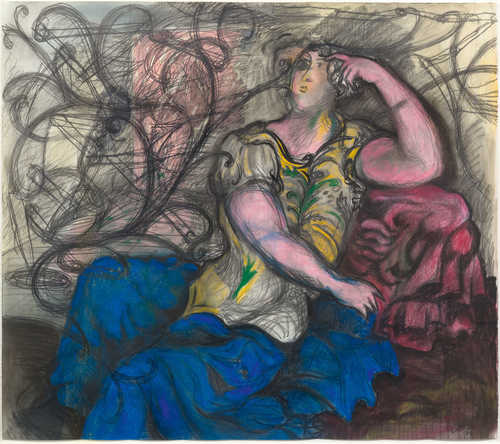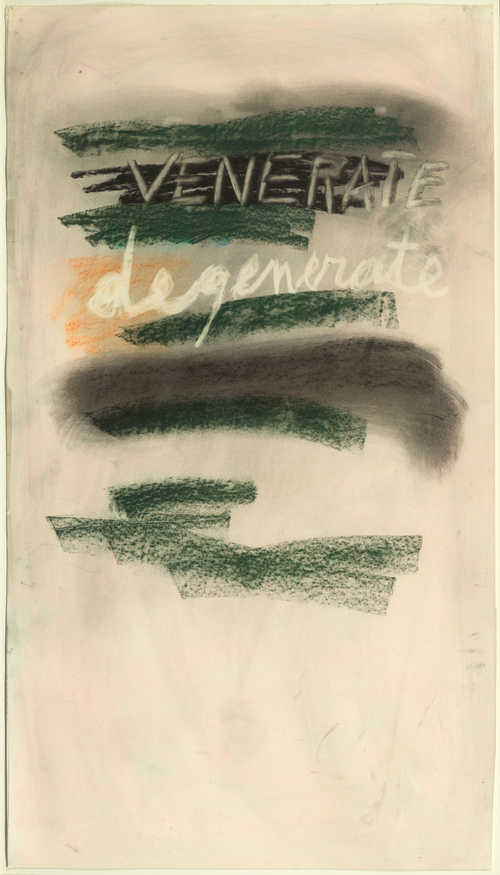
拍品 3474 - A187 战后和当代 - Samstag, 08. Dezember 2018, 02.00 PM
SANDRO CHIA
(Florence 1946–lives and works i.a. in Rome)
Venerate, Degenerate (diptych). 1986.
Pastel and watercolour on paper.
Signed and dated lower right: Chia 68.
133.5 x 152.5 cm and 134 x 76 cm.
Provenance:
- Galerie Bruno Bischofberger, Zurich (verso with the label).
- Purchased from the above in 1987 by the present owner, since then private collection Mallorca/Switzerland.
Exbition: Berlin 1992, Sandro Chia. Nationalgalerie Berlin, 11 September - 8 November 1992, p. 119 (with colour ill.).
“Conceptual art and Minimalism were all so pure, so we needed to do something forbidden, impure, vital.” (Sandro Chia)
Sandro Chia, along with Francesco Clemente (*1952) and Enzo Cucchi (*1949) was one of the main exponents of the Italian Transavanguardia, which developed from Arte Povera as an autonomous artistic direction in the mid 1970s and internationally showed close parallels to the German Junge Wilden. Their works are characterised by a distinctive eclecticism.
The practice of looking back to and drawing on old artistic styles can be seen very clearly in the present piece by the Florentine artist Sandro Chia. The diptych, with its large central panel and narrow side panels is reminiscent of an altar. In addition, the artist harks back to the classic painting on panel, which after the love of experimentation demonstrated by Arte Povera and ZERO was almost an innovation, at least that is how it immediately strikes the viewer.
Chia’s deep-rootedness in his Tuscan homeland is consistently present in his works. In “Venerate, Degenerate” a large corpulent woman is seated leaning against a pile of stones and looks out at the viewer. “The figures in Chia’s pictures do no endure or suffer passively the ingenious process of painting, but on the contrary they assert themselves with a self-contained and earthy cheerfulness. Often with a double or triple pair of eyes, which seem to move and roll in lively fashion, they betray an unbroken lust for life. These are burlesque figures, as in a game of satyrs, who do not care about high art and understand the refined demands of living and loving. They clearly feel at home in their world and pursue their needs quite unashamedly. “ (Exh. Cat. Sandro Chia. Nationalgalerie Berlin, 11 September – 8 November 1992, pp. 8f.) Thus, Dieter Honisch, describes the strength, energy and love of life in Chia’s figures, which is inherent also in the figure depicted here.
What is typical of his works is that the viewer can indeed assume that the scene takes place in a landscape but cannot identify it. The expressive colours and dynamic strokes are characteristic of Chia’s mature work. The composition of the woman appears well known to us, but because of the Transavantguardia artist’s eschewal of symbols and attributes, just as with the landscape, we cannot establish an exact definition.
Sandro Chia was born in Florence in 1946. After studying at the Accademia di Belle Arti in Florence, in 1969 he travelled through Europe and India. In 1970 he moved to Rome, where in 1971 he had his first solo show at the Galleria La Salita. In 1980 he found an atelier in New York and shuttled between New York and Ronciglione near Rome. As well as numerous solo shows and countless group shows in Europe and the United States, Sandro Chia took part in Documenta 7 in 1982 and in 1984 and 1988 in the 41st and 43rd Venice Biennales.
- Galerie Bruno Bischofberger, Zurich (verso with the label).
- Purchased from the above in 1987 by the present owner, since then private collection Mallorca/Switzerland.
Exbition: Berlin 1992, Sandro Chia. Nationalgalerie Berlin, 11 September - 8 November 1992, p. 119 (with colour ill.).
“Conceptual art and Minimalism were all so pure, so we needed to do something forbidden, impure, vital.” (Sandro Chia)
Sandro Chia, along with Francesco Clemente (*1952) and Enzo Cucchi (*1949) was one of the main exponents of the Italian Transavanguardia, which developed from Arte Povera as an autonomous artistic direction in the mid 1970s and internationally showed close parallels to the German Junge Wilden. Their works are characterised by a distinctive eclecticism.
The practice of looking back to and drawing on old artistic styles can be seen very clearly in the present piece by the Florentine artist Sandro Chia. The diptych, with its large central panel and narrow side panels is reminiscent of an altar. In addition, the artist harks back to the classic painting on panel, which after the love of experimentation demonstrated by Arte Povera and ZERO was almost an innovation, at least that is how it immediately strikes the viewer.
Chia’s deep-rootedness in his Tuscan homeland is consistently present in his works. In “Venerate, Degenerate” a large corpulent woman is seated leaning against a pile of stones and looks out at the viewer. “The figures in Chia’s pictures do no endure or suffer passively the ingenious process of painting, but on the contrary they assert themselves with a self-contained and earthy cheerfulness. Often with a double or triple pair of eyes, which seem to move and roll in lively fashion, they betray an unbroken lust for life. These are burlesque figures, as in a game of satyrs, who do not care about high art and understand the refined demands of living and loving. They clearly feel at home in their world and pursue their needs quite unashamedly. “ (Exh. Cat. Sandro Chia. Nationalgalerie Berlin, 11 September – 8 November 1992, pp. 8f.) Thus, Dieter Honisch, describes the strength, energy and love of life in Chia’s figures, which is inherent also in the figure depicted here.
What is typical of his works is that the viewer can indeed assume that the scene takes place in a landscape but cannot identify it. The expressive colours and dynamic strokes are characteristic of Chia’s mature work. The composition of the woman appears well known to us, but because of the Transavantguardia artist’s eschewal of symbols and attributes, just as with the landscape, we cannot establish an exact definition.
Sandro Chia was born in Florence in 1946. After studying at the Accademia di Belle Arti in Florence, in 1969 he travelled through Europe and India. In 1970 he moved to Rome, where in 1971 he had his first solo show at the Galleria La Salita. In 1980 he found an atelier in New York and shuttled between New York and Ronciglione near Rome. As well as numerous solo shows and countless group shows in Europe and the United States, Sandro Chia took part in Documenta 7 in 1982 and in 1984 and 1988 in the 41st and 43rd Venice Biennales.
CHF 20 000 / 30 000 | (€ 20 620 / 30 930)
以瑞士法郎銷售 CHF 23 300 (包含買家佣金)
所有信息随时可能更改。


